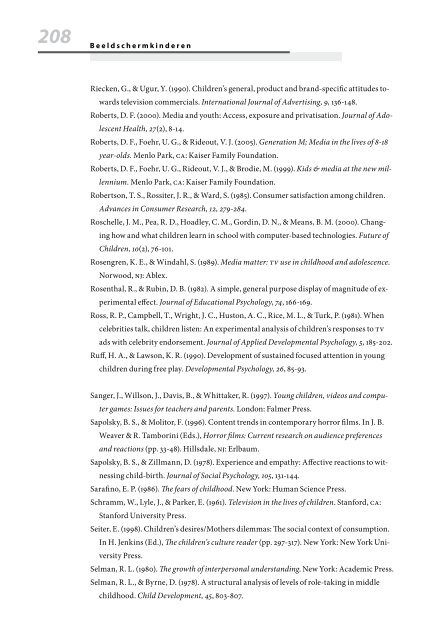Download PDF: Beeldschermkinderen - Kijkwijzer
Download PDF: Beeldschermkinderen - Kijkwijzer
Download PDF: Beeldschermkinderen - Kijkwijzer
Create successful ePaper yourself
Turn your PDF publications into a flip-book with our unique Google optimized e-Paper software.
208 <strong>Beeldschermkinderen</strong><br />
Riecken, G., & Ugur, Y. (1990). Children’s general, product and brand-specific attitudes to-<br />
wards television commercials. International Journal of Advertising, 9, 136-148.<br />
Roberts, D. F. (2000). Media and youth: Access, exposure and privatisation. Journal of Ado-<br />
lescent Health, 27(2), 8-14.<br />
Roberts, D. F., Foehr, U. G., & Rideout, V. J. (2005). Generation M; Media in the lives of 8-18<br />
year-olds. Menlo Park, CA: Kaiser Family Foundation.<br />
Roberts, D. F., Foehr, U. G., Rideout, V. J., & Brodie, M. (1999). Kids & media at the new mil-<br />
lennium. Menlo Park, CA: Kaiser Family Foundation.<br />
Robertson, T. S., Rossiter, J. R., & Ward, S. (1985). Consumer satisfaction among children.<br />
Advances in Consumer Research, 12, 279-284.<br />
Roschelle, J. M., Pea, R. D., Hoadley, C. M., Gordin, D. N., & Means, B. M. (2000). Chang-<br />
ing how and what children learn in school with computer-based technologies. Future of<br />
Children, 10(2), 76-101.<br />
Rosengren, K. E., & Windahl, S. (1989). Media matter: TV use in childhood and adolescence.<br />
Norwood, NJ: Ablex.<br />
Rosenthal, R., & Rubin, D. B. (1982). A simple, general purpose display of magnitude of ex-<br />
perimental effect. Journal of Educational Psychology, 74, 166-169.<br />
Ross, R. P., Campbell, T., Wright, J. C., Huston, A. C., Rice, M. L., & Turk, P. (1981). When<br />
celebrities talk, children listen: An experimental analysis of children’s responses to TV<br />
ads with celebrity endorsement. Journal of Applied Developmental Psychology, 5, 185-202.<br />
Ruff, H. A., & Lawson, K. R. (1990). Development of sustained focused attention in young<br />
children during free play. Developmental Psychology, 26, 85-93.<br />
Sanger, J., Willson, J., Davis, B., & Whittaker, R. (1997). Young children, videos and compu-<br />
ter games: Issues for teachers and parents. London: Falmer Press.<br />
Sapolsky, B. S., & Molitor, F. (1996). Content trends in contemporary horror films. In J. B.<br />
Weaver & R. Tamborini (Eds.), Horror films: Current research on audience preferences<br />
and reactions (pp. 33-48). Hillsdale, NJ: Erlbaum.<br />
Sapolsky, B. S., & Zillmann, D. (1978). Experience and empathy: Affective reactions to wit-<br />
nessing child-birth. Journal of Social Psychology, 105, 131-144.<br />
Sarafino, E. P. (1986). The fears of childhood. New York: Human Science Press.<br />
Schramm, W., Lyle, J., & Parker, E. (1961). Television in the lives of children. Stanford, CA:<br />
Stanford University Press.<br />
Seiter, E. (1998). Children’s desires/Mothers dilemmas: The social context of consumption.<br />
In H. Jenkins (Ed.), The children’s culture reader (pp. 297-317). New York: New York Uni-<br />
versity Press.<br />
Selman, R. L. (1980). The growth of interpersonal understanding. New York: Academic Press.<br />
Selman, R. L., & Byrne, D. (1978). A structural analysis of levels of role-taking in middle<br />
childhood. Child Development, 45, 803-807.







